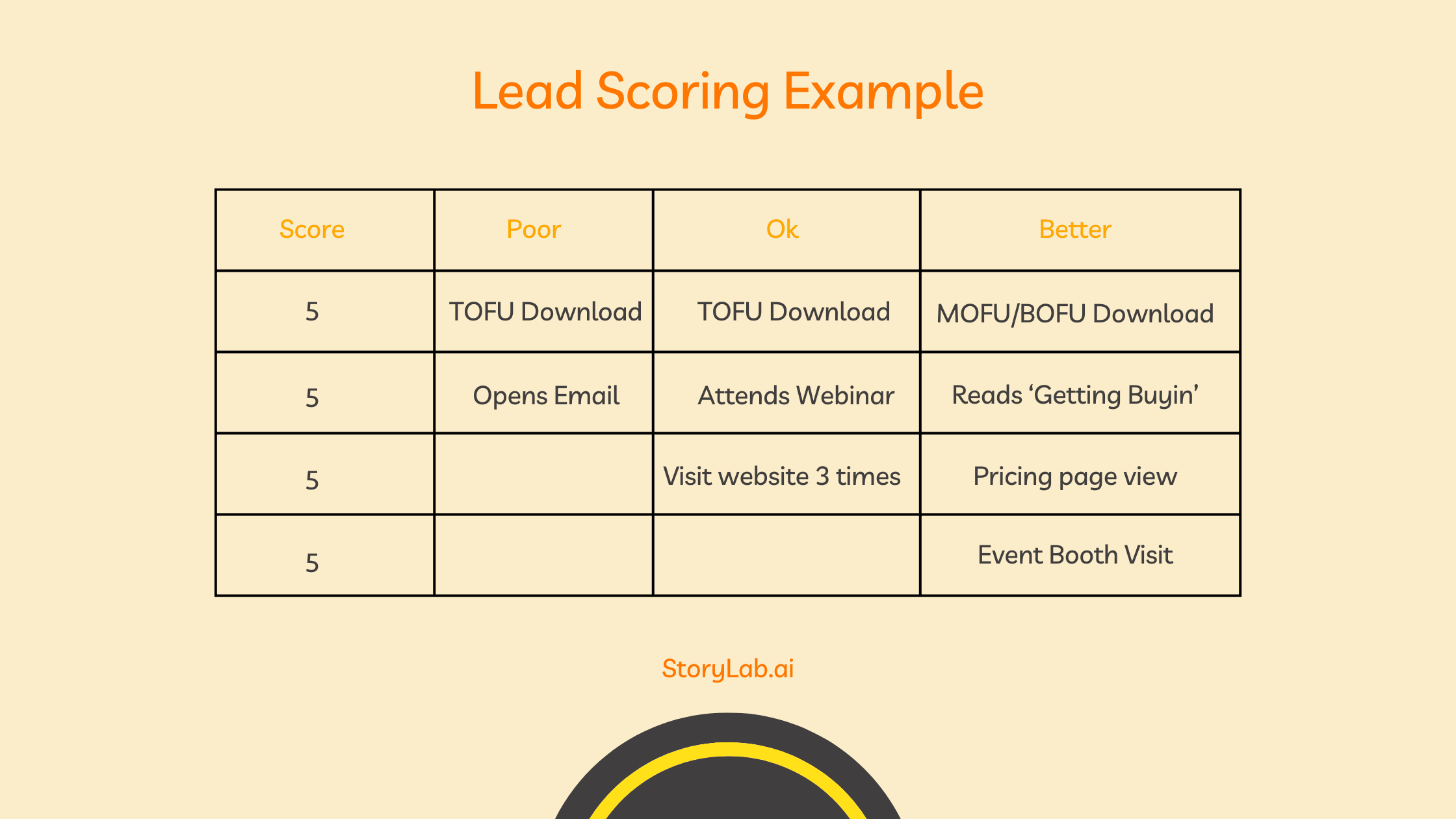How to Improve your Lead Generation Strategy
Finding the balance between quantity / quality and beyond.

Getting more website traffic and capturing leads is only half the battle. In this article, we´re going to discuss what you need to consider to improve your Lead Generation Strategy.
For the last decade and a half we have been using lead magnets to capture contact information. Attracting prospects to landing pages with gated content that is potentially useful or helpful to them. Lead generation can be a valuable resource for businesses to drive engagement but they must master to thrive in today’s competitive landscape. Lead Generation is still an effective tool for driving pipeline and revenue for companies but the efficiency is dwindling. In this article, we delve into the intricacies of attracting leads, nurturing them, and scoring their potential to maximize conversions, revenue, and Improve your Lead Generation Strategy.
Lead generation holds immense value for businesses seeking growth and success but it has been abused to the point of becoming focused on contact information not quality prospects. Let´s explore the significance of attracting leads and highlight the consequences of focusing solely on quantity at the expense of conversion rates and how to shift to a better strategy.
Related: How to Improve your Lead Generation with the Help of AI.
Chapters:
- Libérer le potentiel de Lead Generation
- Le piège des approches de génération de leads axées sur la quantité
- La vraie mesure de Lead Generation Succès : taux de conversion
- Améliorer la Lead Generation avec la qualité à l'esprit
- Trouver l'équilibre pour une croissance durable
- Attirer des prospects de qualité
- L'art du lead nurturing
- Dévoiler la puissance du lead scoring
- L'approche basée sur les données
- Améliorez votre Lead Generation de Marketing
- QFP
Unleashing the Potential of Lead Generation

Lead generation serves as the lifeblood of any thriving business. By attracting leads, we create opportunities to engage with potential customers and showcase our category, brand, and offerings.
Through targeted marketing efforts, we have the opportunity to capture the attention and interest of our audience, drawing them to our website or landing pages in hopes of converting them to leads.
This influx of leads presents us with a challenge and an opportunity. We have the opportunity to nurture relationships with our audience, better understand their needs, and guide them along the buyer’s journey.
We also have the challenge of nurturing prospects that we only looking for information in an attempt to prepare them to speak to sales.
The Pitfall of Quantity-Driven Lead Gen Approaches

While it may be tempting and has become the norm to pursue a high quantity of leads, solely focusing on quantity can lead to dire consequences.
The pursuit of sheer numbers often neglects the importance of quality and conversion rates.
The typical result is that businesses may end up with a vast pool of leads that lack genuine interest or potential to convert into customers.
This not only wastes money and team resources but also diminishes the effectiveness of our lead generation efforts. This vicious cycle of poor conversion rates leading to poor industry conversion rate benchmarks has led to continually declining performance and higher lead targets for marketing teams.
We need to Improve our Lead Generation Strategy.
The True Measure of Lead Generation Success: Conversion Rates

Conversion rates serve as a vital metric for evaluating the success of our lead generation strategy and sales funnel.
Rather than fixating on an ever increasing number of leads, we should prioritize the quality and intent of the leads that we put into and progress through the sales funnel.
High conversion rates signify that we are attracting and nurturing leads who are genuinely interested in our offerings and have a higher likelihood of becoming loyal customers.
By focusing on conversion rates, we can make our process cheaper and more customer-friendly by allocating our resources effectively, nurturing meaningful relationships, and ultimately maximizing revenue.
Elevating Lead Generation with Quality in Mind

To optimize lead generation, we must shift our mindset towards quality over quantity.
By understanding the needs of our target audience and tailoring our marketing efforts accordingly, we can attract leads who best align with our ideal customer profile.
This targeted approach ensures that our resources are allocated to those who have a genuine interest and a higher probability of conversion. Through personalized interactions, valuable content, and nurturing strategies, we can foster relationships that lead to meaningful engagements and ultimately drive conversions.
Striking the Balance for Sustainable Growth

Lead generation should always prioritize quality, with conversion rates as the true measure of success.
While a high quantity of leads is definitely enticing, it is the quality of leads that holds the key to sustainable growth and profitability.
By shifting our focus towards attracting leads with a higher potential for conversion, we ensure that our efforts yield fruitful results.
Let us strive for balance, where quantity serves as a complement to quality, creating a robust lead generation strategy and ecosystem that propels our business toward long-term success.
Attracting Quality Leads

Everything in marketing and sales goes back to laying a strong foundation, lead generation is no different,
businesses must understand their target audience inside out. Market research, customer surveys, sales call recording, and analyzing customer data, can provide valuable insights into their needs, pain points, and preferences.
Armed with this information, we can tailor our marketing efforts to create compelling campaigns and content that resonate with our ideal customers. Whether through search engine optimization, social media, or targeted advertising, our goal is to capture the attention and interest of prospects, driving them to our website or landing pages to convert into leads. Content assets and resources are developed based on the information we have gathered about our audience.
The content ranges from Top of Funnel (TOFU), Middle of Funnel (MOFU), and Bottom of Funnel (BOFU) assets. The closer to the bottom, the fewer prospects will want it but they are more likely to be interested in your product. The closer to the top of the funnel the more people will consume it but they will be less likely to need your product.

The Art of Lead Nurturing
Attracting leads is only the first step; the real magic lies in nurturing those leads.
Lead nurturing involves building relationships with prospects and guiding them along the buyer’s journey.
Here, email marketing takes center stage, allowing us to deliver personalized and relevant content directly to their inboxes. By providing valuable insights, educational resources, and addressing their problems and pains, we can establish trust and credibility.
The key is keeping leads engaged, nurturing their interest, and gently guiding them toward taking the desired actions, such as requesting demos, signing up for trials, or exploring further resources.
Unveiling the Power of Lead Scoring

Lead scoring is a vital tool in the lead nurturing process, enabling businesses to prioritize their efforts and allocate resources effectively.
It involves assigning scores or rankings to leads based on their interactions and engagement levels.
By quantifying their level of interest, we can focus our attention on leads who exhibit the highest potential for conversion. However, striking the right balance is crucial. We must resist the temptation to lower the bar to qualify more leads as marketing qualified leads (MQLs). Quality should remain the guiding principle to ensure that leads progressing through the sales funnel possess a genuine interest in our offerings.
Let’s use 3 simple examples of lead scoring to show our point.
The actual numbers used don’t make much difference, I’ve seen 1-10 being used to score actions and thousands used to score demographics, firmographics, engagement, etc.
For our purposes, each activity gets a score of 5. Higher scores are obviously more difficult to obtain so from left to right the difficulty rises.
If I use 20 as my lead score threshold, I probably have a good chance of creating an MQL that shouldn’t be there and wasting the BDRs time on outreach.
If we extrapolate this over thousands of leads per month, we either have a lot of pipeline or a lot of wasted spend depending on the option I choose.

The Data-Driven Approach
To excel in lead generation, a data-driven approach is paramount.
Regular analysis of key metrics, such as conversion rates, email engagement, website traffic, and lead-to-customer conversion rates, provides valuable insights into the effectiveness of our strategies.
By leveraging these insights, we can identify areas for improvement, optimize our lead generation tactics and strategy, and enhance the overall effectiveness of our marketing efforts. This allows us to dive into conversions point and understand how we can improve each step which should ultimately improve our revenue.
Improve Your Lead Generation Strategy

Mastering the art of lead generation, nurturing, and scoring is vital to delivering growth in existing marketing strategies.
By strategically attracting leads with valuable resources, nurturing their interest through personalized interactions, and implementing effective lead scoring techniques, we can maximize conversions and revenue.
Embracing a data-driven approach allows us to continuously monitor and refine our strategies, ensuring that we stay ahead in the ever-evolving landscape of lead generation.
As we embark on this journey, let us unleash the true potential of our businesses and forge meaningful connections with our prospects, leading them on a path to becoming loyal customers.
Now that we have discussed the benefits of lead generation and the challenge of ensuring that your program doesn’t stray from delivering quality leads to the sales team. The problem is that most companies have poor-performing lead generation programs with poor conversion rates and subpar ROI.
With every company also using the same tactic and diluting the space with lower-quality content and reduced lead scoring standards, we are swimming in a pool of valueless sameness. This leads to the evolution of our marketing activities to Demand Generation. A strategy that can be much more powerful for your organization.
This shift from Lead Generation to Demand Generation is less about the titles themselves and more about the shift from ‘Your Intent’ to ‘Their Intent’
FAQ
What is a lead generation strategy?
A lead generation strategy is a plan of action designed to attract and convert potential customers (leads) into interested buyers, using various marketing tactics and channels.
How important is content marketing in a lead generation strategy?
Content marketing is crucial as it attracts potential leads through valuable, relevant content, nurturing their interest and guiding them towards making a purchase.
What role do landing pages play in lead generation?
Landing pages are essential in converting visitors into leads. They provide targeted information and a clear call-to-action (CTA) relevant to the user’s interest.
How can social media be used for lead generation?
Social media can generate leads by promoting engaging content, hosting live events, and using targeted advertising to reach potential customers.
What is the impact of SEO on lead generation?
SEO helps in making your website more visible to potential leads in search engine results, driving organic traffic, and increasing the chances of conversion.
Can email marketing be effective for lead generation?
Email marketing is highly effective in lead generation by nurturing leads with personalized content, offers, and updates, encouraging them to engage further with your brand.
What are the benefits of using automation in lead generation?
Automation streamlines the lead generation process, from capturing leads to nurturing them with personalized content, improving efficiency and effectiveness.
How do paid advertising campaigns contribute to lead generation?
Paid advertising campaigns can target specific audiences with precision, quickly generating a large volume of leads and increasing brand visibility.
What is the role of analytics in lead generation strategy?
Analytics provide insights into which tactics are most effective, helping to refine strategies, improve targeting, and maximize ROI.
How can businesses ensure their lead generation strategy is customer-focused?
By understanding customer needs and preferences, providing value through content and interactions, and ensuring a positive user experience at every touchpoint.
What are the best practices for optimizing a website for lead generation?
Best practices include having a user-friendly design, clear CTAs, optimized landing pages, persuasive copy, and forms that are simple and easy to complete.
How can businesses use webinars for lead generation?
Webinars can be effective for lead generation by offering valuable information or training, attracting interested individuals, and collecting lead information through registration.
What is the significance of lead scoring in a lead generation strategy?
Lead scoring involves ranking potential leads based on their likelihood to convert, helping businesses prioritize their efforts and tailor their approach to different segments.
How does influencer marketing contribute to lead generation?
Influencer marketing can increase brand visibility and credibility, reaching new audiences and generating leads through the influencer’s endorsement.
Can blogging be an effective tool for lead generation?
Blogging is effective for lead generation as it drives traffic to your website, establishes authority, and encourages readers to engage further with your brand.
What role does networking play in lead generation?
Networking, both online and offline, can open new opportunities for lead generation by building relationships and increasing referrals and word-of-mouth marketing.
How can customer reviews and testimonials be used in lead generation?
Customer reviews and testimonials build trust and credibility, influencing potential leads’ decision-making and encouraging them to engage with your business.
What is the importance of a call-to-action (CTA) in lead generation?
A CTA is crucial as it guides potential leads on what action to take next, whether it’s signing up, downloading a resource, or contacting your business.
How can businesses leverage video content for lead generation?
Video content can be highly engaging and persuasive, used to showcase products, explain services, or provide valuable information, thereby generating leads.
What is the future outlook for lead generation strategies?
Future lead generation strategies are likely to focus more on personalization, AI and automation, interactive content, and integration of advanced analytics for more targeted efforts.
Author bio
 Brian has 15+ years as a marketing strategist and visionary leader with a track record of transforming the marketing function and propelling it to new heights for several SaaS companies as an advisor, consultant, and employee. He has spearheaded highly successful campaigns that captivated target audiences, optimizing the marketing funnel to maximize conversion rates, and accelerate sales cycles.
Brian has 15+ years as a marketing strategist and visionary leader with a track record of transforming the marketing function and propelling it to new heights for several SaaS companies as an advisor, consultant, and employee. He has spearheaded highly successful campaigns that captivated target audiences, optimizing the marketing funnel to maximize conversion rates, and accelerate sales cycles.
Brian Cohen is also the Co-Founder and CEO at StoryLab.ai. You can find more info about Brian on LinkedIn.
Interesting articles
- Demystifying Google’s Core Web Vitals: A Guide to SEO Success
- AI-Powered Content Creation: Tools and Techniques for Marketers
- 5 ways of using AI to Improve your Marketing Efforts
- The Importance of Branding in Digital Content Creation
- How to Write Press Releases for Optimal Results
- Revitalize Your Blog: Fresh Content Ideas to Engage Your Audience and Generate Leads
- The Psychology Behind Choosing The Right Color For Your App Designing
- Avoid Data Loss in Google Workspace: A Comprehensive Guide
Master the Art of Video Marketing
AI-Powered Tools to Ideate, Optimize, and Amplify!
- Spark Creativity: Unleash the most effective video ideas, scripts, and engaging hooks with our AI Generators.
- Optimize Instantly: Elevate your YouTube presence by optimizing video Titles, Descriptions, and Tags in seconds.
- Amplify Your Reach: Effortlessly craft social media, email, and ad copy to maximize your video’s impact.